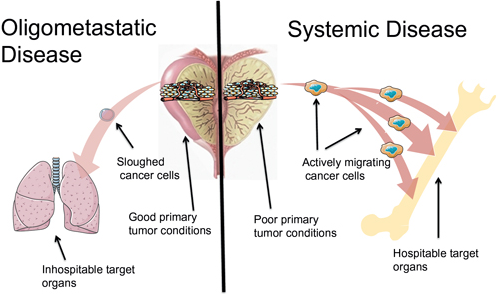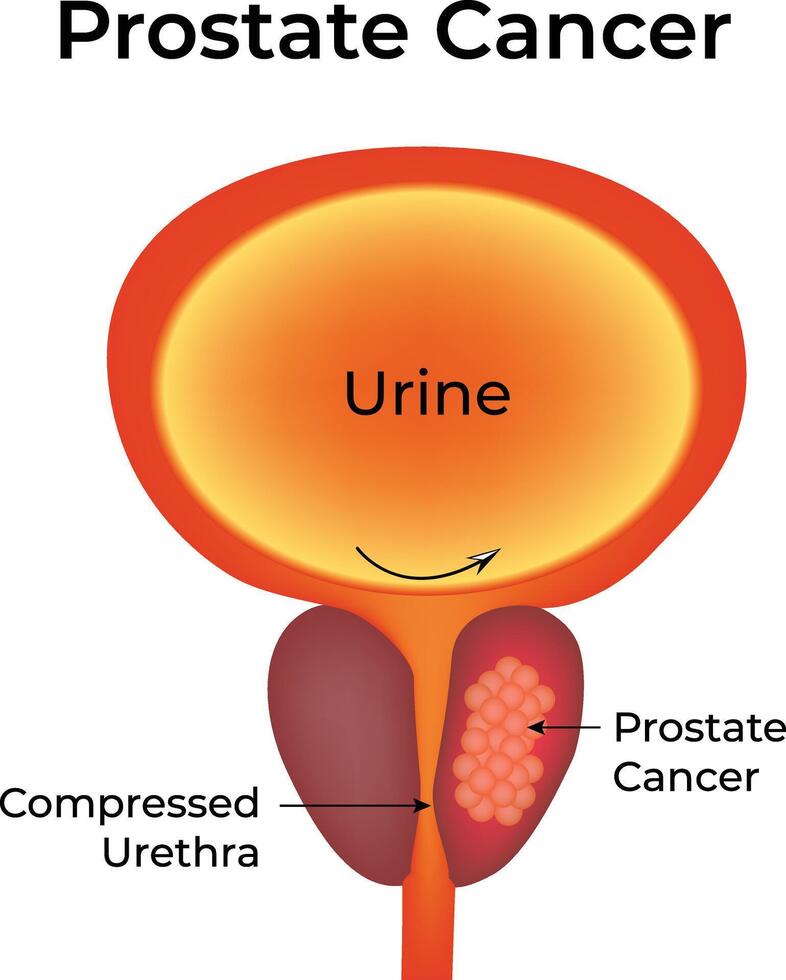Oligometastatic Disease in Prostate Cancer: Stage 4, Treatment, Life Expectancy
Oligometastatic prostate cancer is an intermediate state between localized and widespread metastatic disease. First described by Hellman and Weichselbaum in the 1990s, this concept reflects a biological condition where metastases are limited in number and location, often making them amenable to aggressive local treatment. In the context of prostate cancer, this state is increasingly recognized due to improved imaging and refined staging.
Patients with oligometastatic prostate cancer typically present with ≤5 metastatic lesions, most commonly in bones or lymph nodes. With early identification, it becomes possible to personalize treatment strategies that can significantly delay disease progression and improve survival outcomes.
What Is Oligometastatic Prostate Cancer?
Oligometastatic prostate cancer refers to a clinical state in which a patient has a limited number of metastatic sites—typically between 1 and 5—detected on imaging. It is distinct from polymetastatic disease (widespread spread) and can either be:
- Synchronous: Detected at the time of initial diagnosis.
- Metachronous: Occurs after initial treatment of localized disease.
This categorization has clinical significance, as it influences treatment decisions. Advanced imaging modalities such as PSMA PET-CT have improved the detection of low-volume metastatic disease, thus expanding the population that falls into the oligometastatic category.
Stage 4 Oligometastatic Prostate Cancer Survival Rate
Stage 4 prostate cancer includes all metastatic disease. Within this stage, oligometastatic patients tend to have a more favorable prognosis than those with widespread metastases. Studies indicate:
- Median survival: 4–8 years with optimal treatment.
- 5-year overall survival: Approaches 50–60% in selected patients.
- Progression-free survival: Can be extended with metastasis-directed therapy (MDT) and systemic treatment.
The STAMPEDE and ORIOLE trials have provided evidence that MDT (e.g., stereotactic radiotherapy) to limited metastases improves outcomes when combined with systemic therapy.
Oligometastatic Prostate Cancer Life Expectancy
Life expectancy for men with oligometastatic prostate cancer depends on various factors:
- PSA level
- Gleason score
- Number and location of metastases
- Response to androgen deprivation therapy (ADT)
With contemporary management, many patients can expect life expectancy of 5–10 years, particularly if they respond well to ADT and receive metastasis-directed radiotherapy or surgery.
Is Oligometastatic Prostate Cancer Curable?
While not traditionally considered curable, emerging data suggest that some cases may be effectively controlled long-term or potentially eradicated:
- In highly selected patients, combination of ADT, radiotherapy, and surgical resection of the primary tumor and metastases can lead to prolonged remission.
- The term “cure” remains controversial, but durable control for 10+ years has been documented.
Curative intent treatment is increasingly being explored in clinical trials, especially in patients with low-volume, hormone-sensitive disease.
Oligometastatic Prostate Cancer Treatment
Treatment strategies are multidisciplinary and typically include:
1. Androgen Deprivation Therapy (ADT)
First-line systemic approach to reduce testosterone levels, which fuel prostate cancer growth.
2. Metastasis-Directed Therapy (MDT)
Includes stereotactic body radiotherapy (SBRT) or surgical resection of metastases.
3. Radiotherapy to the Primary Tumor
Recent studies (e.g., STAMPEDE trial) show that treating the prostate itself improves outcomes even in the presence of metastases.
4. Next-Generation Hormonal Agents
Abiraterone, enzalutamide, apalutamide may be added for enhanced disease control.
5. Chemotherapy
Docetaxel may be used in cases with high disease burden or hormone-resistant progression.
6. Immunotherapy & Trials
Participation in clinical trials (e.g., using PSMA-targeted therapies or immunotherapeutics) is strongly encouraged.
Oligometastatic Prostate Cancer Radiotherapy
Radiotherapy plays a central role in both local and systemic disease control:
- SBRT to metastases: Can delay the need for systemic therapy and reduce disease burden.
- Whole-pelvis radiotherapy: Sometimes considered for nodal oligometastatic spread.
- Primary site radiotherapy: Shown to improve survival when added to systemic therapy (per STAMPEDE).
Key trials like ORIOLE and STOMP support the concept that targeted radiotherapy can delay progression and defer systemic therapy in some cases.
Oligometastatic Prostate Cancer PowerPoint (PPT) – What to Include
For physicians or educators preparing a presentation (PPT) on this topic, consider the following structure:
- Definition and Epidemiology
- Biological Basis of Oligometastasis
- Diagnostic Tools (PSMA, Choline PET, MRI)
- Prognostic Factors
- Treatment Modalities (ADT, SBRT, systemic therapy)
- Key Trials: STAMPEDE, ORIOLE, STOMP
- Case Studies
- Future Directions and Ongoing Trials
Each section should include clinical images, survival curves, and treatment algorithms for clarity.
STAMPEDE and Oligometastatic Prostate Cancer
The STAMPEDE trial (Systemic Therapy in Advancing or Metastatic Prostate Cancer: Evaluation of Drug Efficacy) has revolutionized the treatment landscape:
- Arm H of STAMPEDE demonstrated that radiotherapy to the prostate improves survival in patients with low metastatic burden.
- These findings support local treatment in metastatic disease, challenging the traditional paradigm of systemic-only therapy.
- The trial set a precedent for aggressive multimodal treatment even in Stage 4 patients, especially those with ≤3 bone metastases.
STAMPEDE has become a cornerstone for redefining curative-intent strategies in oligometastatic disease.
FAQ – Frequently Asked Questions
What does oligometastatic prostate cancer mean?
Oligometastatic prostate cancer refers to a state of prostate cancer where the disease has spread beyond the prostate but is limited in the number and location of metastases—typically five or fewer. This state may allow for more targeted and aggressive treatments with curative intent, unlike widespread metastases.
What is the longest someone has lived with prostate cancer?
There are documented cases of patients living more than 15 to 20 years after a diagnosis of prostate cancer, including metastatic forms, particularly when the disease is well-managed with hormonal therapy and newer systemic treatments. Longevity is significantly improved in oligometastatic cases where aggressive treatment is possible.
How long does one live with prostate cancer?
Survival with prostate cancer varies widely based on stage, grade, and treatment. For localized prostate cancer, the 10-year survival rate exceeds 95%. For metastatic cases, especially oligometastatic, many patients live 5–10 years or longer with modern treatment approaches. Life expectancy depends on response to therapy, PSA kinetics, and overall health.
What is the difference between metastatic and oligometastatic?
Metastatic prostate cancer implies that cancer has spread to distant sites, regardless of the number of lesions.
Oligometastatic prostate cancer is a subcategory of metastatic disease where the number of metastases is limited (usually ≤5) and potentially amenable to targeted therapy. It is considered biologically less aggressive and may respond better to localized treatments, including radiotherapy or surgery.
Progress in Oligometastatic Prostate Cancer
Significant progress has been made in identifying and managing oligometastatic prostate cancer:
- Advanced imaging such as PSMA PET-CT allows earlier and more accurate detection.
- Metastasis-directed therapy (MDT), especially stereotactic body radiotherapy (SBRT), has shown to delay disease progression.
- Trials like STAMPEDE, ORIOLE, and STOMP have validated the survival benefit of combining local and systemic treatment.
- Multimodal strategies are increasingly explored in clinical practice and trials, offering a more hopeful outlook for selected patients.
Oligometastatic disease is now recognized not merely as an intermediate stage, but as a potentially actionable window of therapeutic opportunity.
Oligometastatic prostate cancer represents a unique, biologically distinct state with potential for long-term control and, in select cases, possible cure. Advances in imaging, radiotherapy, and systemic therapies have enabled more precise treatment planning and improved patient outcomes. While not yet the standard of care, personalized approaches targeting both the primary tumor and limited metastases are reshaping how we manage this subset of patients.
Early detection and multidisciplinary collaboration remain key to optimizing outcomes in this evolving field.












